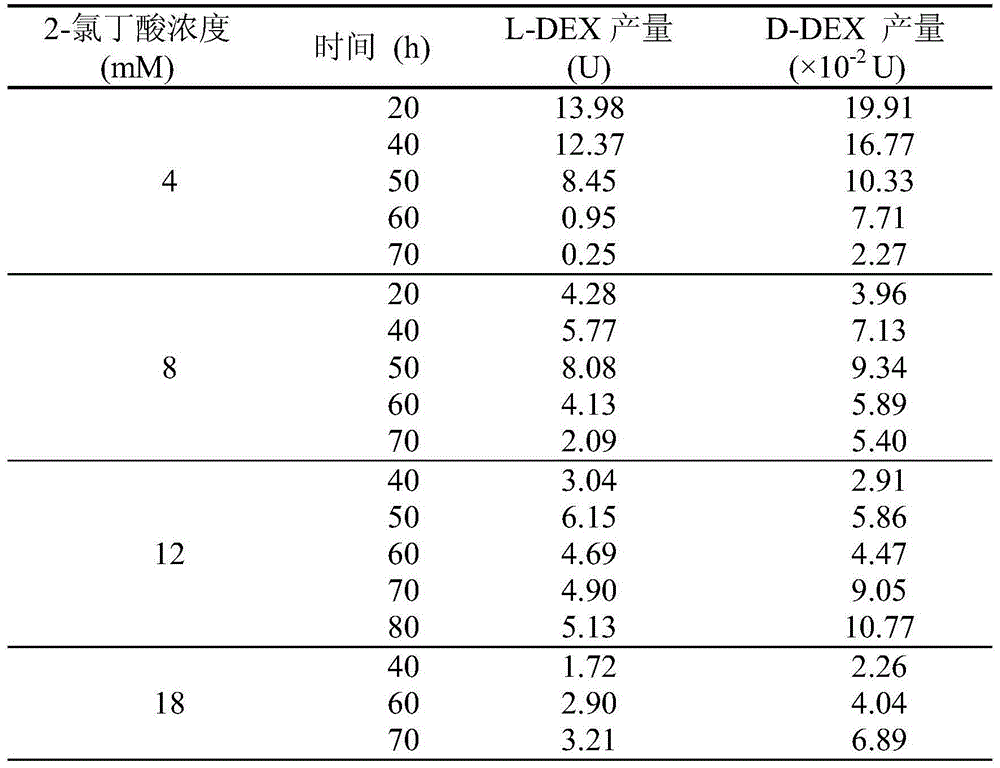Method for selectively increasing haloacid dehalogenase yield
A haloacid dehalogenase and selective technology, applied in the field of selectively improving the production of L-2-haloacid dehalogenase by Pseudomonas, can solve the problem of low yield and avoid uncertainty performance, increase output, and maintain stable output
- Summary
- Abstract
- Description
- Claims
- Application Information
AI Technical Summary
Problems solved by technology
Method used
Image
Examples
Embodiment 1
[0016] Seed solution preparation:
[0017] (1) The symbiotic Pseudomonas sp. DEH138 (Pseudomonassp. DEH138) used in the present invention is stored in the China Industrial Microorganism Culture Collection and Management Center, and the number is CICC10431.
[0018] (2) Preparation of inorganic salt basal medium: Na 2 HPO 4 12H 2 O(12g / L),NaH 2 PO 4 2H 2 O (1g / L), NaCl (30g / L), yeast extract powder (0.1g / L), (NH 4 ) 2 SO 4 (2.0g / L), MgSO 4 ·7H 2 O (0.1g / L), the balance is water, adjust the pH to 7.0-7.5.
[0019] (3) 2-chloropropionic acid solid medium: add 0.04g / L bromothymol blue (as a pH indicator) to the inorganic salt basic medium, the final concentration is 18g / L agar, the final concentration is 8-20mmol / L of 2-chloropropionic acid.
[0020] (4) 2-chloropropionic acid liquid medium: add 2-chloropropionic acid at a final concentration of 8-20 mmol / L to the inorganic salt basal medium.
[0021] (5) 2216E medium: 5.0g / L, yeast extract powder 1.0g / L, FeCl30.1g / L,...
Embodiment 2
[0024] Effects of auxiliary carbon source and inducer types and culture methods on the production of dehalogenase:
[0025](1) The control in this example is the L-DEX obtained under normal culture conditions (2-chloropropionic acid as the only carbon source (2-chloropropionic acid liquid medium) cultured DEH13840~50h, OD600nm reached 0.4~0.6) The output of D-DEX is 2.46U and 0.21U respectively.
[0026] (2) DEH138 was cultured with 10mM glycolic acid, lactic acid, hydroxybutyric acid or glucose as the sole carbon source (respectively replacing 2-chloropropionic acid in 2-chloropropionic acid liquid medium), and the obtained bacteria had no dehalogenase activity .
[0027] (3) With 10mM iodoacetic acid, 2-fluoropropionic acid, 3-chloropropionic acid, 2-chlorobutyric acid, 2-bromobutyric acid, 2,2-dichloropropionic acid, 2-chloropropionamide or 2- When DEH138 was cultured with bromopropionamide as the only carbon source (respectively replacing 2-chloropropionic acid in 2-chlo...
Embodiment 3
[0046] Effects of lactic acid concentration and culture time on dehalogenase production:
[0047] (1) 10mM lactic acid, 10mM 2-chlorobutyric acid culture DEH13810h, 30h, 40h, 50h, 60h.
[0048] (2) 20mM lactic acid, 10mM 2-chlorobutyric acid culture DEH13810h, 30h, 40h, 50h, 60h.
[0049] (3) 30mM lactic acid, 10mM 2-chlorobutyric acid culture DEH13810h, 30h, 40h, 50h, 60h.
[0050] (4) As a result, the highest yield of L-DEX was 12.45U, which was 5.1 times that of 2-chloropropionic acid as the sole carbon source (the control in Example 2), and the highest yield of D-DEX was 0.16U, which remained stable , the results are shown in Table 1.
PUM
 Login to View More
Login to View More Abstract
Description
Claims
Application Information
 Login to View More
Login to View More - R&D
- Intellectual Property
- Life Sciences
- Materials
- Tech Scout
- Unparalleled Data Quality
- Higher Quality Content
- 60% Fewer Hallucinations
Browse by: Latest US Patents, China's latest patents, Technical Efficacy Thesaurus, Application Domain, Technology Topic, Popular Technical Reports.
© 2025 PatSnap. All rights reserved.Legal|Privacy policy|Modern Slavery Act Transparency Statement|Sitemap|About US| Contact US: help@patsnap.com



